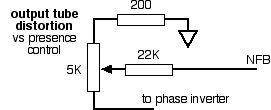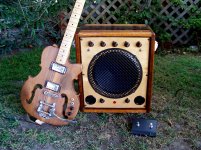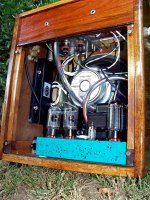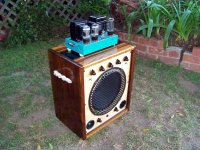How much negative feedback is too much?
I've read many claims that too much is bad, but there never is a percentage or ratio to determine when you are putting too much in the phase inverter.
I have a guitar amp I'm building, 6L6 Bassman based clone, and put a variable NFB control instead of a presence control. See drawing for the values, but I get a range from ~1%(22K/200) to ~24%(22K/5.2K). I do not get any problems from these values but I would like to know how to determine where failure will start. I have gone up to 34% before and still had no problems.
The addition of this is an awesome mod btw... From nice clean to beautiful distortion on the output tubes. The amp does not need to be cranked to get that breakup tone, it breaks up much earlier with very little NFB.
Thanks, Daniel
I've read many claims that too much is bad, but there never is a percentage or ratio to determine when you are putting too much in the phase inverter.
I have a guitar amp I'm building, 6L6 Bassman based clone, and put a variable NFB control instead of a presence control. See drawing for the values, but I get a range from ~1%(22K/200) to ~24%(22K/5.2K). I do not get any problems from these values but I would like to know how to determine where failure will start. I have gone up to 34% before and still had no problems.
The addition of this is an awesome mod btw... From nice clean to beautiful distortion on the output tubes. The amp does not need to be cranked to get that breakup tone, it breaks up much earlier with very little NFB.
Thanks, Daniel
Attachments
I suspect the "bad" part is because NFB changes the nature of the distortion, and thus the tone. I presume at high NFB the tone becomes more like the typical high-NFB transistor amp that does hard clipping, something clearly undesirable for for guitar tone. Or if it IS desired, it's more easily achieved and controlled with a line-level distortion circuit.
Also, with higher NFB and output signals approaching hard-clipping square waves, this can set up high spiky voltages in the output transformer's stray inductance, and lead to arcing, DEFINITELY a bad thing.
Also, with higher NFB and output signals approaching hard-clipping square waves, this can set up high spiky voltages in the output transformer's stray inductance, and lead to arcing, DEFINITELY a bad thing.
Don't sweat the square waves. With enough gain everything looks like a square wave, As far as hard clipping sounding bad I built a transistor amp years back that a guy loved because his Champ sounded too mushy to him. To each his own (the speaker plays a big part in it also). Above he has the adjustability so tune to taste.
Cool man! How many hours u got on the 6L6s? Those burn marks on the glass are pretty neat. Cool idea to have the rag-holder built into the cab side. The only thing missing is a basket weave grill front.
edit: I zoomed in and see now that's not a rag, but the rope handle...cool!
edit: I zoomed in and see now that's not a rag, but the rope handle...cool!
Another thing to remember is that where the feedback is applied is also important. You are feeding back to the PI. So you have much less gain in the forward path than you would if you were feeding back to an input stage as is done with a lot of amps.
There are charts showing how feedback effects distortion suppression (Baxandall) , but also enhancement. Up to 6dB 3rd and above harmonic distortion increases while 2nd Harmonic distortion decreases, and beyond 6dB all distortioin is increasingly suppressed.
I can't find the original article, but Nelson Pass has the figure on page 9 of "Audio Distortion and Feedback" (good article) which can be found here:
http://www.passlabs.com/pdfs/articles/distortion_and_feedback.pdf
There are charts showing how feedback effects distortion suppression (Baxandall) , but also enhancement. Up to 6dB 3rd and above harmonic distortion increases while 2nd Harmonic distortion decreases, and beyond 6dB all distortioin is increasingly suppressed.
I can't find the original article, but Nelson Pass has the figure on page 9 of "Audio Distortion and Feedback" (good article) which can be found here:
http://www.passlabs.com/pdfs/articles/distortion_and_feedback.pdf
Semper: Those tubes are used and came from an old McMartin PA amp. I thought those 'burn' spots were original. And I thought about a grill cover. I won't be making another amp with the controls on the front, too difficult. In fact I'd prefer to make a head and speaker cab separately. This amp is for my nephew, 17 and a killer guitarist for his age. And, yes, those are braided hemp rope handles I made-no other handle would do justice...
Gimp: Nice article, but a bit over my head. I liked the part about objectionists and subjectionists though, pretty funny. I may experiment w/ feeding back to an earlier stage, thanks for the suggestion...
Gimp: Nice article, but a bit over my head. I liked the part about objectionists and subjectionists though, pretty funny. I may experiment w/ feeding back to an earlier stage, thanks for the suggestion...
- Status
- This old topic is closed. If you want to reopen this topic, contact a moderator using the "Report Post" button.
- Home
- Live Sound
- Instruments and Amps
- negative feedback



